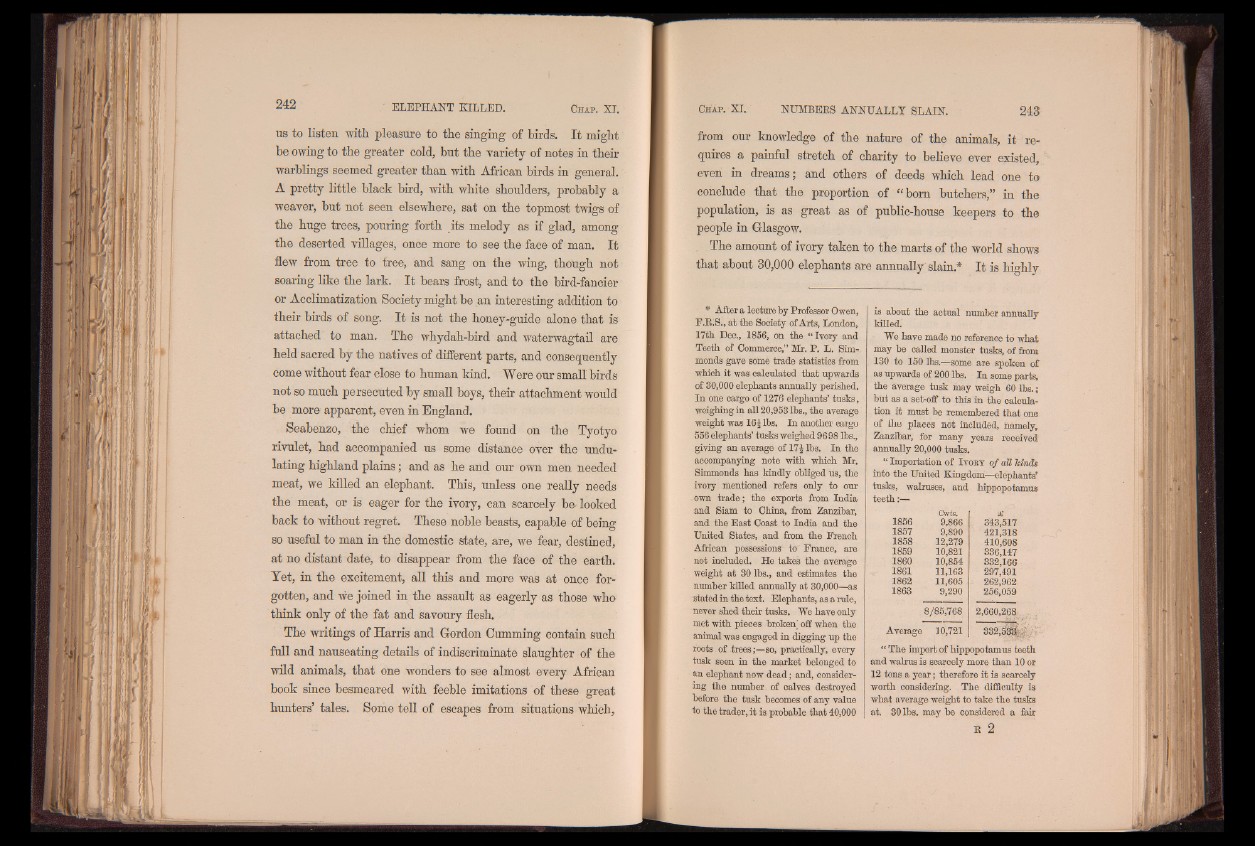
us to listen -with pleasure to the singing of birds. I t might
he owing to the greater cold, but the variety of notes in their
warblings seemed greater than with African birds in general.
A pretty little black bird, with white shoulders, probably a
weaver, but not seen elsewhere, sat on the topmost twigs of
the huge trees, pouring forth its melody as if glad, among
the deserted villages, once more to see the face of man. I t
flew from tree to tree, and sang on the wing, though not
soaring like the lark. I t bears frost, and to the bird-fancier
or Acclimatization Society might be an interesting addition to
their birds of song. I t is not the honey-guide alone that is
attached to man. The whydah-bird and waterwagtail are
held sacred by the natives of different parts, and consequently
come without fear close to human kind. Were our small birds
not so much persecuted by small boys, their attachment would
be more apparent, even in England.
Seabenzo, the chief whom we found on the Tyotyo
rivulet, had accompanied us some distance over the undulating
highland plains; and as he and our own men needed
meat, we killed an elephant. This, unless one really needs
the meat, or is eager for the ivory, can scarcely be- looked
back to without regret. These noble beasts, capable of being
so useful to man in the domestic state, are, we fear, destined,
at no distant date, to disappear from the face of the earth.
Yet, in the excitement, all this and more was at once forgotten,
and we joined in the assault as eagerly as those who
think only of the fat and savoury flesh.
The writings of Harris and Gordon Cumming contain such
full and nauseating details of indiscriminate slaughter of the
wild animals, that one wonders to see almost every African
book since besmeared with feeble imitations of these great
hunters’ tales. Some tell of escapes from situations which,
from our knowledge of the nature of the animals, it requires
a painful stretch of charity to believe ever existed,
even in dreams; and others of deeds which lead one to
conclude that the proportion of “ bom butchers,” in the
population, is as great as of public-house keepers to the
people in Glasgow.
, The amount of ivory taken to the marts of the world shows
that about 30,000 elephants are annually slain.* It is highly
* After a lecture by Professor Owen,
F.R.S., at the Society of Arts, London,
17th Dec., 1856, on the “ Ivory and
Teeth of Commerce,” Mr. P. L. Sim-
monds gave some trade statistics from
which it was calculated that upwards
of 30,000 elephants annually perished.
In one cargo of 1276 elephants’ tusks,
weighing in all 20,953 lbs., the average
weight was 16$ lbs. In another cargo
556 elephants’ tusks weighed 96 98 lbs.,
giving an average of 17$ lbs. In the
accompanying note with which Mr.
Simmonds has kindly obliged us, the
ivory mentioned refers only to our
own trade; the exports from India
and Siam to China, from Zanzibar,
and the East Coast to India and the
United States, and from the French
African possessions' to France, are
not included. He takes the average
weight at 30 lbs., and estimates the
number killed annually at 30,000—as
stated in the text. Elephants, as a rule,
never shed their tusks. We have only
met with pieces broken^ off when the
animal was engaged in digging up the
roots of trees;—so, practically, every
tusk seen in the market belonged to
an elephant now dead; and, considering
the number, of calves destroyed
before the tusk becomes of any value
to the trader, it is probable that 40,000
is about the actual number annually
killed.
We have made no reference to what
may be called monster tusks, of from
130 to 150 lbs.—some are spoken of
as upwards of 200 lbs. In some parts,
the average tusk may weigh 60 lbs.;
but as a set-off to this in the calculation
it must be remembered that one
of the places not included, namely,
Zanzibar, for many years received
annually 20,000 tusks.
“ Importation of I v o b y of all kinds
into the United Kingdom—elephants’
tusks, walruses, and hippopotamus
teeth;—■
Cwts. £
1856 9,866 343,517
1857 9,890 421,318
1858 12,279 410,608
1859 10,821 336,147
1860 10,854 332,166
1861 11,163 297,491
1862 11,605 262,962
1863 9,290 256,059
8/85,768 2,660,268
Average 10,721 332,5Sf£
“ The import of hippopotamus teeth
and walrus is scarcely more than 10 or
12 tons a year; therefore it is scarcely
worth considering. The difficulty is
what average weight to take the tusks
at. 30 lbs. may be considered a fair
E 2